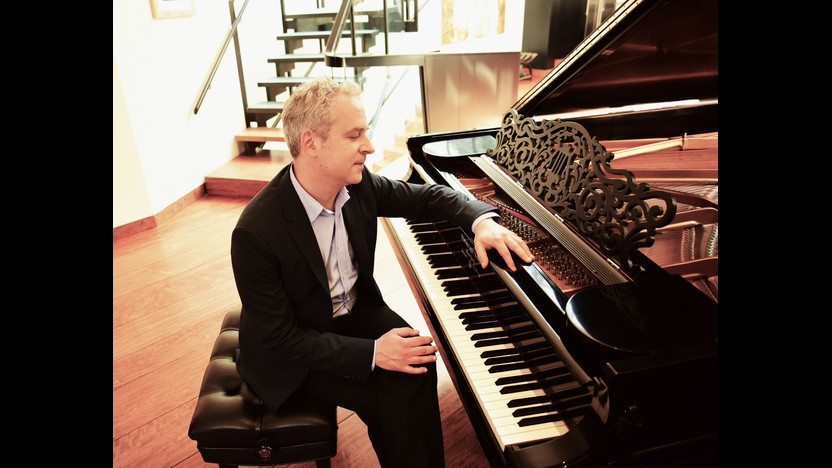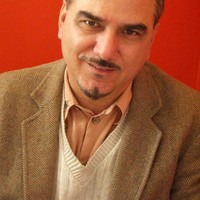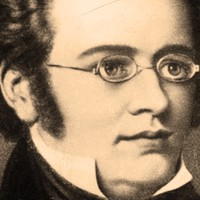Tour with Jeremy Denk



My title, O Mikros, O Megas was inspired by the opening lines of Axion Esti, by the great contemporary Greek poet, Odysseas Elytis: “Aftos O Kosmos, O Mikros, O Megas” (This tiny world, this enormous world). There are no direct literal connections to the words, only the feeling of the intended ambiguity; certainly no superficial dynamic nor density parallels. In fact, it is to me that within the quietest and most inwardly moments of the work, the world seems to fully impose its power and enormity. At the same time, the figurative “flip-side” of my work's title could well be “This tiny fleeting life, this huge eternal life” – a reflection on recent world circumstances including the tumbling world, loss of friends and my own personal advancement into the foothills of an ageless maturity.
Thinking and hearing into the sonic qualities and potentials of the string orchestra, my creative and inward sensibilities seemed to eschew many “fast and loud” possibilities for those of quietude and grace. I fought with this tendency, frankly, during the word's composition, however, in the end, textures of long, quietly floating tensions won out, for the most part. There are faster movements among the four and imploding episodes, but the heart and largeness of the work are made manifest in the second and last. All movements end quietly and the last, with my most preferred ending, a “dot dot dot” figure. In fact, in the score, the performers are given the option of repeating the final phrase for as long as desired, until the “end” of the work is felt.
George Tsontakis ©2016
 Listen to Audio
Listen to Audio
Wolfgang Amadeus Mozart delighted his fans in Vienna by introducing a dozen new piano concertos between 1784 and 1786, and he might have kept up that pace if a war with the Ottoman Empire hadn’t scattered the aristocrats who subscribed to those concerts. He entered the Piano Concerto No. 23 in A Major into his catalog of completed compositions on March 2, 1786, and he probably debuted it on one of the three programs he presented that spring.
Preliminary sketches, which may date from as early as 1784, included a pair of oboes in the instrumentation, but the final version substituted clarinets instead. The concerto’s first movement gives the woodwinds far more attention than they would have been accustomed to at that time, starting with unaccompanied phrases in the orchestra’s introductory tutti and continuing in the conversational development section.
Later editions notched the tempo of the middle movement up to Andante, but Mozart’s manuscript for this heavy-hearted movement clearly calls for the slower and more affecting Adagio tempo. Again the woodwinds play an outsized role in accompanying and answering the piano, and they also introduce the only wholly cheerful passage in the movement, in the contrasting major key. Minor-key episodes within the rondo finale rehash some of the angst of the slow movement, but the main recurring theme always reaffirms the jovial home key with its definitive leaps.
Aaron Grad ©2024
 Watch Video
Watch Video
While working full-time as a teaching assistant, taking compositions lessons twice a week, and playing viola in a student orchestra, the 17-year-old Franz Schubert managed to write new music at an astonishing rate that averaged at least 65 measures of music every single day. His efforts that year included his Symphony No. 2, which at most might have received a reading from a student orchestra. Not a note of his music had reached the public yet, and during his entire short life he never managed to secure a single performance of any symphony.
As a student composer in Vienna, Schubert could not help but be engulfed by the towering achievements of Haydn, Mozart and Beethoven (who had by then debuted eight of his nine symphonies). Like Beethoven before him, Schubert used the instrumentation and general outline of Haydn’s final London symphonies as a point of entry. In Schubert’s Symphony No. 2, the instrumentation, slow introduction and the use of a minuet third movement instead of a Beethovenian scherzo all point to Haydn’s influence. One particular trick found all over Haydn’s symphonies comes in the Allegro vivace body of Schubert’s first movement, when the main theme enters in the strings at a pianissimo dynamic before being repeated fortissimo by the full orchestra.
The Andante second movement takes the form of a theme and variations, with a simple and song-like theme that adds a playful extra measure in its second half. The climactic fourth variation moves to C minor, which returns as the surprising key center for the Menuetto. Before the finale launches, four introductory measures bridge the harmonic distance back to the home key of B-flat major. Then, like horses on the hunt, the orchestra gallops off at a Presto tempo.
— © Aaron Grad
Aaron Grad ©2016
Tickets to this concert are not available through the SPCO Ticket Office and must be purchased through the 92nd Street Y.
Acclaimed as one of the finest chamber orchestras in the world, the primarily unconducted and musician-led Saint Paul Chamber Orchestra makes its 92Y debut in its first New York appearance since Carnegie Hall in 2011. The SPCO will be joined by Artistic Partner, pianist Jeremy Denk. The concert begins with a New York premiere by George Tsontakis, whose Violin Concerto was nominated for Best Classical Contemporary Composition as recorded by the SPCO. Then Jeremy Denk, a MacArthur “genius” Fellow and one of 92Y’s most popular artists, performs Mozart’s lyrical Piano Concerto in A major, followed by Schubert’s exuberant Symphony No. 2, written when the composer was 17.
Get driving directions and find nearby parking.
Find dining options close to the venue.
View seating charts to find out where you'll be seating.
SPCO concerts are made possible by audience contributions.
For exclusive discounts, behind-the-scenes info, and more:
Sign up for our email club!
